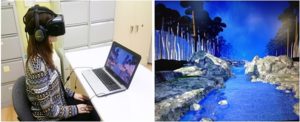
By John M. de Castro, Ph.D.
In today’s Research News article “Virtual reality enhanced mindfulness and yoga intervention for postpartum depression and anxiety in the post COVID era” (See summary below or view the full text of the study at: https://pmc.ncbi.nlm.nih.gov/articles/PMC11973155/ ) Liu and colleagues examined the effectiveness of virtual reality (VR) enhanced mindfulness meditation and yoga training in comparison to traditional training and a no-training control on the symptoms of postpartum depression. They report that the VR enhanced training produced greater decreases in depression, anxiety, and stress and increases in cognitive control than the traditional training or no-treatment controls.
Improve postpartum depression symptoms with virtual reality mindfulness and yoga training.
CMCS – Center for Mindfulness and Contemplative Studies
This and other Contemplative Studies posts are also available on the Contemplative Studies Blog http://contemplative-studies.org
Study Summary
Liu N, Deng J, Lu F, Xiao J. Virtual reality enhanced mindfulness and yoga intervention for postpartum depression and anxiety in the post COVID era. Sci Rep. 2025;15(1):11766. Published 2025 Apr 6. doi:10.1038/s41598-025-96165-6
Abstract
The postpartum period has witnessed increasing rates of depression and anxiety, particularly in the context of the COVID-19 pandemic, with these conditions often co-occurring and being exacerbated by the lingering effects of long COVID. Traditional interventions, such as mindfulness-based stress reduction (MBSR) and yoga, have demonstrated effectiveness in alleviating these symptoms. However, the limitations of in-person sessions, especially in the context of pandemic-related restrictions, highlight the need for accessible, innovative approaches. Integrating Virtual Reality (VR) technology with these traditional practices presents a novel solution, offering immersive, customizable environments that may enhance engagement and therapeutic outcomes. This study evaluates the effectiveness of a VR-enhanced mindfulness and yoga intervention in treating postpartum depression and anxiety in women affected by long COVID, with additional examination of underlying physiological stress markers and cognitive control mechanisms. In this randomized controlled trial, 111 postpartum women were randomly assigned to experimental (VR-enhanced intervention), control (traditional in-person sessions), or blank groups using computer-generated randomization. The 8-week intervention involved thrice-weekly 60-minute sessions. Outcomes were assessed at baseline, post-intervention, and 4-week follow-up using the Edinburgh Postnatal Depression Scale (EPDS), Generalized Anxiety Disorder-7 (GAD-7) scale, salivary cortisol measurements, and an emotional Stroop task. The VR-enhanced intervention group demonstrated significant improvements in both depression (EPDS: P < 0.001, ηp2 = 0.18) and anxiety symptoms (GAD-7: P < 0.001, ηp2 = 0.17), with these therapeutic effects significantly greater than those observed in the control and blank groups (P < 0.001 for both comparisons). These improvements were strongly correlated (r = 0.68, P < 0.001). Supporting these primary outcomes, salivary cortisol levels showed a significant decrease (P < 0.001, ηp2 = 0.13), and cognitive control improved as evidenced by reduced emotional Stroop task conflict effect (P < 0.001, ηp2 = 0.37). Correlation analysis revealed robust associations between improvements in depression and anxiety symptoms and changes in physiological markers in both short-term and long-term outcomes. This study demonstrates that integrating VR technology with traditional mindfulness and yoga practices effectively reduces both postpartum depression and anxiety symptoms in the post-COVID era. The parallel improvements in physiological stress markers and cognitive control provide insight into potential mechanisms underlying these therapeutic effects. These findings underscore the value of immersive technology in enhancing traditional therapeutic approaches for addressing postpartum depression and anxiety in the post-pandemic context.




